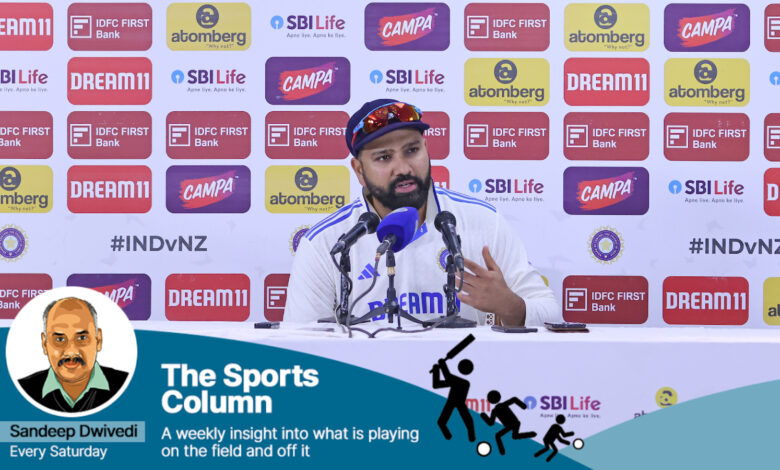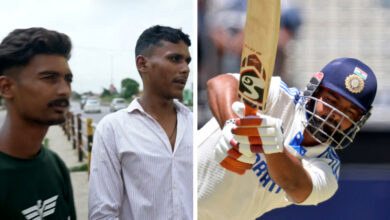The Rohit Sharma press conference that neither Virat Kohli nor MS Dhoni could match | Cricket News

At the end of a day’s play, inside press boxes at cricket arenas around the world, reporters on deadline ask that one important question to each other. “Who’s coming for the press conference?” The answer determines whether one needs to carry on writing a quote-less match report or run to some remote corner of the stadium and len to the player designated for the media interaction.Quotes were once the staple of reporters but in these ‘agent-monitored, over-guarded’ times, when players have been asked to give nothing away, that is not the case. Media interactions have been reduced to a formality. On most days, these are meaningless exchanges where the most obvious questions get asked and answered. The tough ones are either ‘well left’ or stared down.
This has led to an arrangement where reporters ask the players about team news and conditions and get to hear phrases like “taking each game at a time”, “giving their 110 per cent” and “following the process and not worrying about results.” Mostly, a press interaction is a cliche-fest that provides the extra words – marked the quote marks – to a report but doesn’t add any value.
On the second day of the India-New Zealand Test in Bengaluru, something unprecedented happened. It might have sent the Chinnaswamy press box into a tizzy. India had touched a new low in Tests at home, after being all out for 46. The knives were out and the reporters were wondering who to blame. Broadcasters had done their sanitised interviews but no one would put a finger on India’s batting debacle. It was a whodunnit with captain Rohit Sharma, coach Gautam Gambhir, and the batsmen who had ‘scored’ ducks, as the prime suspects.
With no word from the Indian squad and none expected before the deadline, the reporters had penned their caustic first few paras about the home team’s collective failure. A few rewrites would have happened that day as Rohit got on the dias and took to the microphone to take full responsibility for the collapse. He said batting first on the moure-laden pitch was his call and he was wrong in reading the conditions.
It’s not what Rohit’s predecessors would have done. Virat Kohli would get angsty and aggressive in such situations, MS Dhoni would be unresponsive or aloof. With Rohit, there was no confrontation, no stone-walling, it was an honest confession laced with humour.
Rohit managed to present the Bengaluru mountain as a modest molehill. (Sportzpics)The central theme of his explanation was best captured that one line – “Such misjudgments happen to all of us once in a while, no? Do you make the right calls in your office on all 365 days, sir?” With this, the Indian captain was trying to say he too was human. Even the most cynical scribe would connect with Rohit. Memories of missed deadlines, headlines with typos getting printed, and bad copies would have come rushing to those who crave for excellence while fighting the clock on a daily basis.
The day after the Rohit confession, newspapers would carry his honest explanation next to a critical comment on the collapse. The blow would become softer, readers would feel sympathetic for the leader who had owned up. The plea to move on did have an impact. Rohit managed to present the Bengaluru mountain as a modest molehill.
Dealing with the media
During India’s tour to England in 2014, Graeme Swann, having seamlessly moved from the field after retirement to the commentary box, had shared a thing or two about the cat-and-mouse relationship between players and media. Blessed with a sharp mind and a wicked sense of humour, he saw through the press conference farce and wasn’t afraid to share it.
He said on the difficult days – when either the team hadn’t done well or Kevin Pietersen was again in the headlines for the wrong reasons – the team management would invariably choose him to deal with the media. It was believed that the team’s funny man would find a way to de-escalate any volatile situation. The truth was Swann wore his intellect lightly and believed in taking on the problem head-on. He was honest and didn’t beat around the bush.
“Say something like a KP (Kevin Pietersen) issue was on and you know what they (reporters) want to ask you. So, before the press conference, I would tell the media manager when ‘that’ question will be asked. It mostly comes as the third question. They would ask: So what do you think about tomorrow? What about your form? I almost want to tell them, please ask the question and save everyone the trouble. You come out with it, I will come out with it too and we all can go. We are all wasting 10 minutes of our lives.”
It is exactly what Rohit did. Since the Indian media didn’t wait till the third question to address the elephant in the room and Rohit too played it straight, the media interaction was over in 8 minutes or so.
Had it been Kohli, the tone of the interaction would have been different. Go back to his press conference after India’s 36 all out embarrassment in Adelaide on the 2020-21 tour. It was a Covid time online press conference, with the close-up camera capturing every emotion on the Indian captain’s face. One of the questions was about players being in their comfort zone and how that could be a possible reason for India’s lowest Test score ever.
Kohli would launch a counter. “People who want to relate this to comfort zone (of players) should have a reality check.” He would pull up his own team and even undermine the effort of the rivals. “We lacked intent, we made them look more potent than what they really were.”
Meanwhile, Dhoni was indifferent. During the 2015 World Cup, he would keep a room full of reporters waiting for the mandatory pre-game media interaction, as he played football with the team. He tried being funny too – he once called a reporter who asked about his form to sit next to him – but the joke fell flat.
Rohit has made the press conference great again. He doesn’t hide when he fails, nor does he get angry. After the T20 World Cup win, he seems like a man at peace with himself and also his failures.
Send feedback to sandydwivedi@gmail.com







